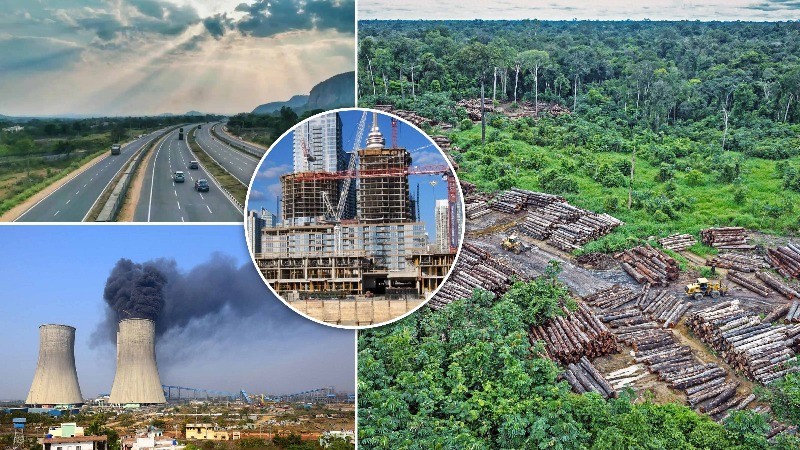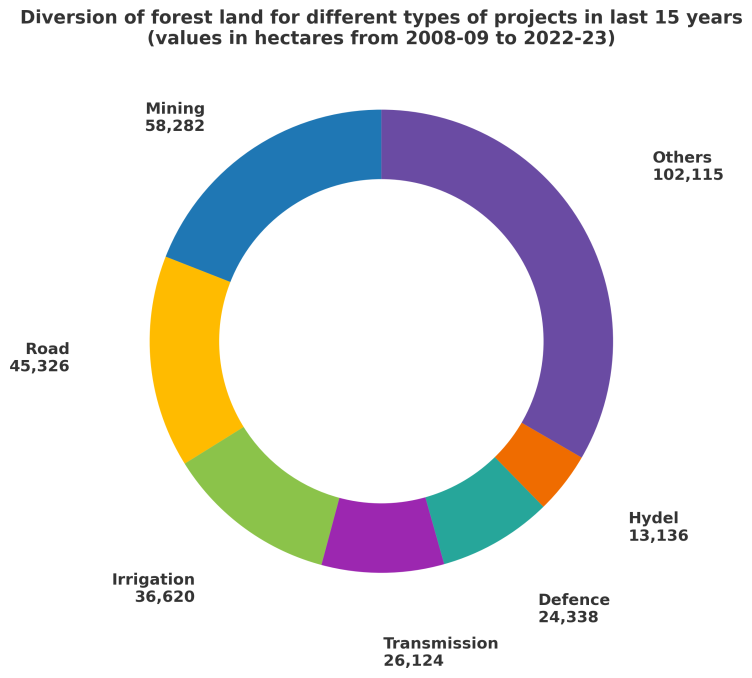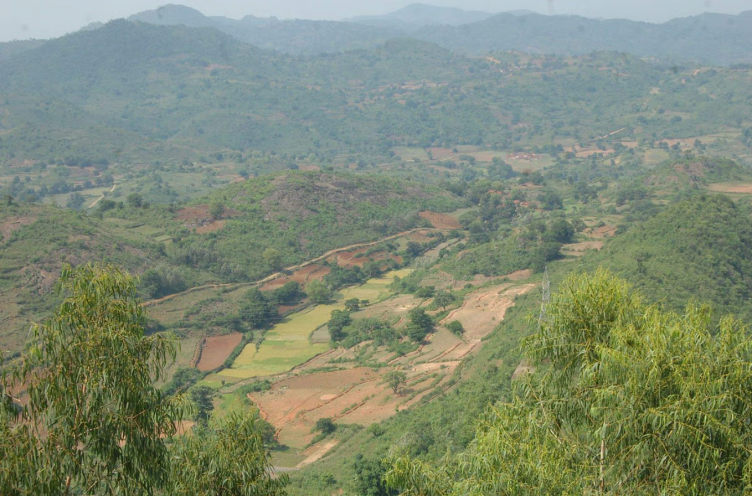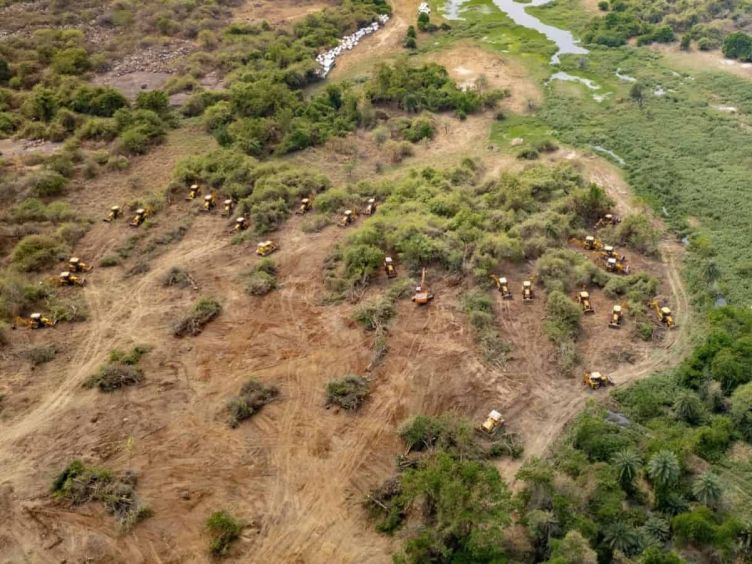
India is transforming rapidly, flourishing with infrastructure, development, and industrial growth. Construction of the Atal corridor, the arrival of the bullet train, mining activities in Chhattisgarh, and many other significant projects are down the pipeline for the South Asian nation. But with all the development, there is another lingering concern. India's forest cover is gradually being depleted, with the green cover diverted for non-forestry purposes, which affects the biodiversity, geological stability, and lives of dependent communities.
In the past 15 years, more than 3 lakh hectares of forest land have been diverted for various non-forestry purposes. According to the Union Environment Ministry, this non-forest use was for 1,73,396.87 hectares of forest area in a decade between 2014-15 and 2023-24. Around 1 lakh hectare (95724.99 ha) was approved in the last five years from 2019 to 2024[1].
'Forest cover' is all the land cover over one hectare with a canopy density above 10%, regardless of legal status or its ecological value, according to the India State of Forests Report (ISFR).
A significant proportion of forest land in India is diverted for industrialization, construction, mining, irrigation, and other development activities. There has been a diversion of 1.5 million hectares of forest land for development since 1980 (most of the tree cover loss came after 2000)[6].
 In the past 15 years, the largest area of forest land has been diverted for mining, as told by the Environment Ministry in Lok Sabha (Data source: Dataful)
In the past 15 years, the largest area of forest land has been diverted for mining, as told by the Environment Ministry in Lok Sabha (Data source: Dataful)Mining projects
Mining is the primary reason for forest diversion, with huge tracts of forest land being cleared to make space for the extraction of minerals. During the period from 2008-09 to 2023, up to 58,282 hectares of forest land were diverted for various mining projects across the country[2]. The Union Environment Ministry gave the nod to 179 projects for coal and other minerals in 17 states from 2019-2024. Odisha was the leading state with 18,979 acres of land diverted for mining during these five years[3].
Construction and development
From 2018 to 2023, the largest area of forest land (19,424 hectares) was diverted for road construction[4]. According to the data provided by the Union Government in the Lok Sabha, about 1,734 square kilometers of forest land was diverted for development activities over a decade (from 2014-15 to 2023-24). This was more than the total geographical area of Delhi[5].
The vested interests of businessmen
Businessmen's vested interests lead to the clearance of millions of hectares of forest lands worldwide. About 500 companies and financial institutions have the highest influence on tropical deforestation, but around 168 of these fail to set any deforestation policies or a public deforestation commitment. While 316 companies have a partial commitment or weak implementation (as per a 2025 Forest 500 analysis conducted by non-profit research group Global Canopy)[9].
If we talk about India, there have been several instances of land diversions for the interests of businessmen, which prevail over public interest in view. The forest lands are now open for private entities, turning them into commercial plantations[10]. An example is the Timber industry in India, where there has been a growth in the forest-based industry sector to increase production to meet the demand and make profits. The logging is not only dangerous for the environment, but is also threatening the rights of the communities[10].
In 2024, a Rs 7,645 crore coal mining project operated by the Adani Group easily got environmental clearance, despite being revoked by the National Green Tribunal (NGT), which directed the Environment Ministry to reexamine the case. The project will impact the socio-economic and health conditions (food and water contamination) of people in 14 villages in Chhattisgarh. Also causing loss of soil fertility and a disruption of local ecosystems[12].
Corrupt ways of politicians
Forest land is often cleared to meet the corrupt needs of politicians, who form a nexus with builders, bureaucrats, and other private holdings to avail profits.
12 hectares of reserved forest land in Kondhwa (near Pune) were diverted for agricultural purposes, then for construction in 1998-99, upon clearance orders of the then Revenue Minister of Maharashtra, Narayan Rane. Giving its verdict, the bench led by the Chief Justice of the Supreme Court of India, BR Gavai, it was pointed out that "the act was totally in breach of public trust to illegally cause gain to private individuals at the cost of sacrificing precious forest land[15]."
The 70,000 crore irrigation scam in Maharashtra, which has the National Congress Party (NCP) leader Ajit Pawar as the main accused. Also known as the Maharashtra Watergate, the scam was silently functioning during 1999-2009, with financial irregularities of Rs. 35,000 crores. The scandal came to light in 2003, involving allegations of mismanagement and corruption in irrigation projects of that period[16].
Not only the politicians, but also the bureaucrats are involved in the misuse of allocated lands and funds. For example, the misuse and misallocation of CAMPA funds in Madhya Pradesh and Uttarakhand. Comptroller and Auditor General (CAG) Audit uncovered the truth of the Rs 607 crore scam in Uttarakhand[13].
The State Governments often emerge to be the real land mafias, where they want to divert most of the forest lands for industrial expansion and taking away the land titles of forest dwellers in mineral-rich areas[14].
These are only a few to be named; the strong nexus among the powerful still continues under the table, possibly turning into a big scam before it comes to light.
Irrigation
In a decade, the Indian Government diverted 36,620 hectares of land for irrigation purposes. In 2019-20, there was a diversion of 4,287.50 ha for 24 irrigation projects in India[17]. The major irrigation projects carried out in the country include: The Indira Gandhi Canal, the Narmada Valley Project, the Sardar Sarovar Dam, the Hirakud Dam, and the Tungabhadra Project, among others. These could provide for widespread irrigation facilities, but also led to the cutting down of trees and the displacement of local communities from the region.
Hydel power generation
Hydel power generation received 13,136 hectares of diverted land from 2008-09 to 2022-23. As India is moving towards an increase in hydropower capacity from 42 GW to 67 GW by 2031-32, along with an increase in the demand, there is a considerable area of land allocated for hydropower generation[18]. Despite environmental concerns, biodiversity loss, and climate change, many hydroelectric projects are being approved in potential regions, including the mountainous regions[19].
About 4,101 hectares of land were diverted for thermal power, and 2,181 hectares for wind power infrastructure.
Other purposes
There are some other non-forestry projects for which lands are diverted. These include: Transmission lines (26,124 hectares), Defence (24,337 hectares), and Railways (9,307 hectares).
This is only about the land diverted by the Government. Apart from this, logging is a major cause of tree cover loss in India from 2010-2020. The dominant drivers of this loss are commodity-driven deforestation and urbanization.
 The Chennai-Salem expressway built across the eight reserves of the Eastern Ghats in Vishakhapatnam is part of the increasing forest diversion in Andhra Pradesh
The Chennai-Salem expressway built across the eight reserves of the Eastern Ghats in Vishakhapatnam is part of the increasing forest diversion in Andhra Pradesh | States | Total hectares of land diverted for non-forestry purposes |
| Punjab | 61,318 |
| Madhya Pradesh | 40,627 |
| Odisha | 28,320 |
| Telangana | 19,419 |
| Gujarat | 16,070 |
| Jharkhand | 15,691 |
| Chattisgarh | 15,082 |
| Uttarakhand | 14,141 |
| Maharashtra | 13,297 |
| Rajasthan | 12,877 |
| Arunachal Pradesh | 12,778 |
| Andhra Pradesh | 11,093 |
The state-wide data shown from 2021-24, however, revealed that Madhya Pradesh saw the largest forest diversion of 14,157.02 hectares in the last three financial years[20].
The above-mentioned states have a large land area, but a smaller state like Manipur, which is spread across an area of 22,347 sq km, as many as 5,72,000 trees cut down within the period from 2014-15 to 2025 (as found in a Right to Information- RTI filed by Kunal Shukla, Social and RTI Activist based in Raipur, Chhattisgarh).
To keep a check on deforestation, thereby conserving forests, and ensure the regulation of forest land diversion for non-forestry uses, the Forest Conservation Act was established in 1980. Unless the Central Government does not approves, the forest land cannot be used for non-forest purposes (other than reafforestation); strictly regulating the dereservation of forests[22].
It was before the enactment of the act during the period between 1951-52 to 1975-76, about 4.5 million hectares of forest lands were diverted due to the lack of any strict conservation measures[11].
After the enforcement of the act in 1980, about 9.9 lakh hectares of forest land have been diverted for non-forestry purposes. This reveals that the average annual rate of diversion decreased to 23,618 hectares. That's why the act holds significance in the forest legislation of India[11].
The rules to carry out the provisions of the Act are notified by the Central Government in the Official Gazette of India, which is later presented before each house of the Parliament. But the Act is amended and implemented to satisfy the interests and demands of development, businessmen, and those in power.
The Amendment of the Forest Conservation Act 1980 has made land diversion of the protected land much easier. Ever since the passage of the amendment, there have been concerns among environmentalists as well as scientists regarding the 'green lungs' of India. As per the amendment, vast areas of forest land are exempted from the forest clearance, and no impact assessment is needed. It allows for the diversion of forest lands for various projects, making it easy to carry out more activities in forest lands[23].
Apart from the Forest Conservation Act, there is also:
The most important condition set forth by the Central Government for the approval of the de-reservation or diversion of forest land for non-forest use is Compensatory Afforestation. The term refers to the planting of trees in compensation for the forests cut down after seeking permission from the Central Government. It is the afforestation done in lieu of the diversion of forest land for non-forestry use[24].
The worry here is can these planted trees restore the diverse flora and fauna of the ecosystem balance maintained by natural forests? Also, the task of finding land for afforestation, with a neglect of saplings. Moreover, the Compensatory Afforestation Fund Management and Planning Authority (CAMPA) funds are often misused and diverted. As per CAG reports, CAMPA funds have been misused in Uttarakhand by forest authorities between 2019-2022, with a case of fund diversion in Madhya Pradesh[13].
As mentioned above, there has to be mandatory approval from the Central Government for forest land diversion, which is applicable even after the Forest (Conservation) Amendment Act 2023. After the final approval by the Center, and fulfillment and compliance of all the necessary provisions, the State Government or Union Territory administration issues the order for diversion, assignment of lease, or dereservation of the forest land[25].
A fine of Rs 857 crore was imposed on National Thermal Power Corporation (NTPC) by the Environment Ministry's forest advisory committee back in 2024, as it carried out coal mining in 156 acres of forest land in Jharkhand without its approval. Notably, the mining was destroying forest areas and streams across the region[26].
The National Green Tribunal (NGT) was established in 2010, primarily to speed up the ongoing environmental issues of the country, at the same time reducing the burden on other Indian courts. It plays a pivotal role in shaping policies and decisions for forest conservation, thereby promoting sustainable development. Whenever there is a substantial environmental question, the NGT exercises its original jurisdiction, while an appellate jurisdiction for various decisions, orders, and rules concerning the environment[27].
In September 2024, the National Green Tribunal (NGT) had sent a notice to the Government of Karnataka for carrying out extensive iron ore mining by diverting over 4,000 acres of forest land (for 15 years).
Additionally, Soil and moisture conservation, along with wildlife management and catchment area plans, are also followed.
Time and again, the Supreme Court has to intervene, ordering a halt to the projects that prove destructive to the environment. Be it the land auction project close to the University of Hyderabad or the Godavarman case. In a big order issued in May 2025, the Supreme Court has directed all States and Union territories to take back the reserved forest lands allotted to any private institutions or individuals for non-forestry purposes[21].
The Supreme Court has been crucial in the interpretation and enforcement of environmental laws, resolving disputes, as well as protecting environmental rights, further shaping governance. It ensures there is sustainability with development, with ecological balance in the country.
 50+ years later, as the infrastructural boost continues, India needs a nationwide Chipko movement again!
50+ years later, as the infrastructural boost continues, India needs a nationwide Chipko movement again!
It was in the 1970s when a grassroots environmental movement in the Himalayan region of India rose. As we look back at the Chipko movement five decades later, it seems like an eye-opener that led to India's start of environmental conservation. It was when the Government and private entities began massive deforestation in the Himalayan villages, exploiting the natural resources, and threatening wildlife as well as the lives of the villagers who sustained themselves on forests for their survival and livelihood[29].
The village women began with a peaceful resistance, where they hugged the trees or embraced them in such a manner as if they were shielding them from the loggers (that's why the word Chipko, which means to cling or hug in Hindi). It was a breakthrough battle aimed at protecting their lands, resources, and ultimately, sustenance. The movement was popularized by Sundarlal Bahuguna[29].
Chipko movement became our very own way of forest conservation, adopted by the masses to protect the Mother Earth, opposing tree felling. Earlier, it was for the 'ownership of the forest use'[29]. But if we adopt the principles of the Chipko movement now, we can protect the forest lands which are still at stake, challenging economic growth, and development norms in India.
 The Ganchibawli Kancha area in Hyderabad, where 400 acres of forest land lie at stake for the construction of an IT Park
The Ganchibawli Kancha area in Hyderabad, where 400 acres of forest land lie at stake for the construction of an IT ParkToday, there is a considerable amount of forest land in India that is at stake, where deforestation is being carried out on a large scale. The seven key deforestation drives currently in function are[28]:
Great Nicobar Island Project: The 72,000 crore mega infrastructure project has led to over a million trees in the Nicobar Island region being at stake today. There has been a diversion of 130.75 sq km of unique tropical forest land in Great Nicobar for this.
University of Hyderabad Land Auction Project: The Telangana Government was all set to auction the urban forest land in Ganchibawli Kancha area close to the University of Hyderabad, to build an IT Park. 400 acres of forest land, home to 730 plant species, 230 bird species, including several species of mammals and reptiles, is under threat due to the land auction.
Aravalli Leopard Corridor destruction: An approximate area of 2 acres has been illegally cleared, with 200 trees cut down in the Aravalli Leopard Corridor in Gurgaon, Haryana. The land is protected under the Punjab Land Preservation Act (PLPA), and serves as an important corridor for leopards and other mammals in the Aravalli region.
Delhi-Dehradun Expressway: To build this expressway from the capital territory to Dehradun, which will reduce travel distance by 2.5 hours, over 7000 trees have been cut down, and more are being cleared.
Western Dedicated Freight Corridor: Nearly 3000+ mangroves have been cleared for freight movement between Mumbai Port to UP's Dadri.
Chandigarh Green Corridor: This would be Chandigarh city's first green corridor, but irony is that for the construction of it, nearly 200 fully grown trees have been cut down.
Kanwar Corridor Project: A 6-lane corridor is being constructed for Kanwar Yatra pilgrims in Uttar Pradesh's Ghaziabad-Meerut-Muzaffarnagar. As of April 2025, 17,607 trees have been cut down. The NGT is investigating the matter, with allegations of unauthorized felling of trees beyond allowed permission.
In order to ensure development, there is excessive pressure on the forests to meet industry demands, agricultural purposes, and forest produce. Experts say that the government data are all underestimates; the reality of disappearing forests is not shown on paper[7]. A 2023 Global Forest Watch report showed a 4,720 sq km loss of forest cover (compared to 2021), while the ISFR stated that there was an increase in tree cover in the country[8]. It can be said that what is known is just the tip of the iceberg. India's forest cover has increased, but how does a culture of 'planted trees' replace the age-old natural forests? The loss of forests is a loss of the ecosystem altogether.